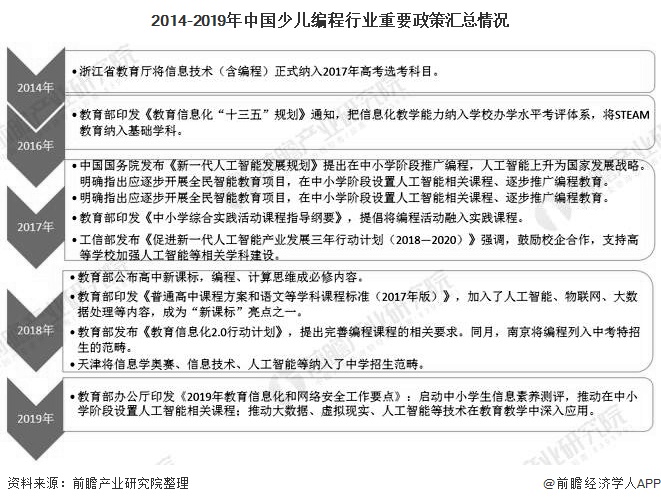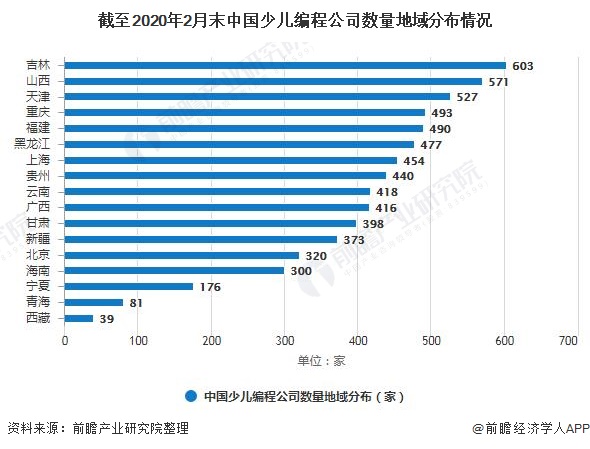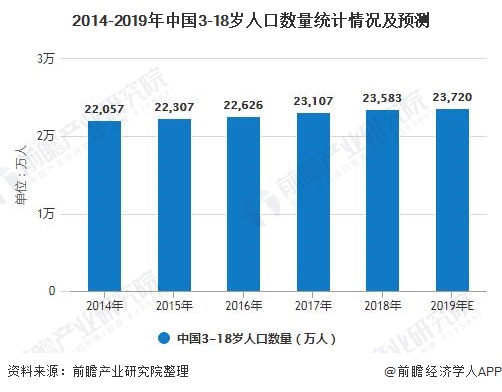Market analysis of children’s programming industry in China in 2020: the number of users is nearly 240 million, and the number of companies in Guangdong Province is far ahead.
China children’s programming market has huge room for growth in the future.
Children’s programming education is to cultivate students’ computational thinking and innovative problem-solving ability through programming game enlightenment, visual graphic programming and other courses. For example, in the process of making a small animation, students split tasks, drag modules and control the progress themselves, so as to understand the concepts of "parallelism", "event handling" and "goal realization". It is mainly aimed at teenagers aged 3-18.
In 2014-2019, there were frequent policies related to children’s programming education in China, and the policy support continued to increase. At present, the teaching scenes of children’s programming education in China are mainly divided into three categories. At present, children’s programming education enterprises take the B-end as the main style, supplemented by the C-end. By the end of February, 2020, there were 7,110 children’s programming companies in China, with Guangdong Children’s Programming Company leading the country, and the top 10 children’s programming education institutions were headquartered in Shenzhen, Beijing and Hangzhou. In 2018, the corresponding age population of children’s programming industry in China is about 236 million. In 2019, it was about 237 million people. China’s children’s programming market has huge room for growth in the future.
1. The development of children’s programming education in China has attracted much attention.
In 2014-2019, China’s children’s programming policies were released one after another. The country has realized the importance of education, and issued many related policies to encourage and support the continuous development of programming education and information education, and promote the popularization and deepening process of programming education at the national basic education level. The policy covers key provinces and cities such as Zhejiang, Shandong, Jiangsu, Tianjin and Chongqing.

2. Distribution of teaching scenes of children’s programming education in China.
The teaching scenes of children’s programming course are divided into three categories: non-public educational institutions, public educational institutions and families. By investigating the enterprises in the industry and comparing the landing degree in three scenarios, it is concluded that the current children’s programming education enterprises mainly adopt B-end, supplemented by C-end.

3. The headquarters of the top 10 children’s programming education institutions in China are concentrated in Shenzhen, Beijing and Hangzhou.
The children’s programming education industry in China has risen rapidly in recent years. With the blessing of multiple factors such as policy support and market maturity, children’s programming institutions have ushered in their own enthusiasm in the cold winter of capital. According to the data of Internet Weekly, the top 10 children’s programming education institutions in China are ranked as follows:

4. The number of children’s programming companies in Guangdong Province leads the whole country.
China’s children’s programming is still small in scale and relatively scattered in institutions, mainly distributed in first-tier cities such as Beishangguangshen and Shenzhen, and offline institutions are also mainly concentrated in first-and second-tier cities.
By the end of February, 2020, there were 438 children’s programming companies in China. In 2019, there were 7110 children’s programming companies in China. By the end of February 2020, domestic children’s programming companies were mainly located in Guangdong, Jiangsu, Shandong and Zhejiang, with 11,770, 3,529, 2,265 and 2,044 children’s programming companies respectively.


5. The overall corresponding age population of children’s programming industry in China is increasing year by year, and it is about 237 million in 2019.
The minimum age of children’s programming students in China is about 3 years old. At this stage, children’s cognitive and understanding abilities have reached a certain level and can begin to participate in such training. The oldest participants are 18-19 years old, that is, senior three students, and the population covered by the training generally coincides with the student group corresponding to K12 education. Therefore, Forward-looking Industry Research Institute adds up the number of students in kindergartens, primary schools, junior high schools and senior high schools in the national statistical bulletin on the development of education published by the Ministry of Education every year, and estimates the population aged 3-18 in China. From 2014 to 2018, the population aged 3-18 in China showed a slow growth trend. In 2018, the corresponding age population of children’s programming industry in China was about 236 million. In 2019, it was about 237 million people.

For the above data and analysis, please refer to Forward-looking Industry Research Institute, which provides solutions for industry, industry planning, industry declaration, and industry.